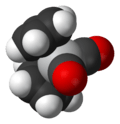Titanocene dicarbonyl
2.png) | |
 | |
| Names | |
|---|---|
| IUPAC name
dicarbonylbis(η5-cyclopentadienyl)titanium(II) | |
| Other names
Dicarbonyldi-π-cyclopentadienyltitanium | |
| Identifiers | |
| 12129-51-0 | |
| Properties | |
| C12H10O2Ti | |
| Molar mass | 234.09 g/mol |
| Appearance | maroon solid pyrophoric |
| Melting point | 90 °C (194 °F; 363 K) |
| Boiling point | Sublimes at 40 to 80 °C (104 to 176 °F; 313 to 353 K) at 0.001 mmHg |
| insoluble | |
| Solubility in other solvents | THF, benzene |
| Structure | |
| tetrahedral | |
| Hazards | |
| Main hazards | flammable |
| Related compounds | |
| Related compounds |
Cp2TiCl2 |
| Except where otherwise noted, data are given for materials in their standard state (at 25 °C [77 °F], 100 kPa). | |
| | |
| Infobox references | |
Dicarbonylbis(cyclopentadienyl)titanium is the chemical compound with the formula (η5-C5H5)2Ti(CO)2, abbreviated Cp2Ti(CO)2. This maroon-coloured, air-sensitive species is soluble in aliphatic and aromatic solvents.[1] It has been used for the deoxygenation of sulfoxides, reductive coupling of aromatic aldehydes and reduction of aldehydes.
Structure and synthesis
Cp2Ti(CO)2 is prepared via the reduction of titanocene dichloride with magnesium under an atmosphere of carbon monoxide.[2]
- (C5H5)2TiCl2 + Mg + 2 CO → (C5H5)2Ti(CO)2 + MgCl2
Both Cp2Ti(CO)2 and Cp2TiCl2 are tetrahedral as are related zirconium and hafnium compounds.
References
- ↑ Sikora, D. J.; Moriarty, K. J.; Rausch, M. D. (1990). "Reagents for Transition Metal complex and Organometallic syntheses". Inorganic Syntheses. 28: 250–251.
- ↑ "Dicarbonylbis(cyclopentadienyl)titanium". Encyclopedia of Reagents for Organic Synthesis. John Wiley & Sons, Ltd. 2001. doi:10.1002/047084289X.rd073.
This article is issued from Wikipedia - version of the 6/17/2016. The text is available under the Creative Commons Attribution/Share Alike but additional terms may apply for the media files.